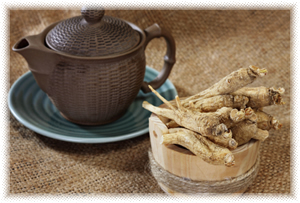| Constituents:Hormone-like saponins,(ginsenosides), volatile oil, sterols, starch, sugars, pectin, vitamins Bl, B2 and B12, choline, fats, minerals |
|

Ginseng has multiple effects, it acts as a tonic system balancer, a stimulant, and an aphrodisiac. Like ginkgo, it relaxes the arteries to improve blood pressure and circulation, which are an important part of a healthy sexual response. Ginseng traditionally has been used to restore sex drive in men. Studies suggest that ginseng increases interest in sex by altering the action of the neuro-transmitter dopamine in the brain. Unlike many sexual herbs, ginseng does not increase testosterone, so avoids the side effect of increased aggression an overabundance of testosterone can produce.
Ginseng is one the best known and widely prescribed herbs in Chinese medicine. Unfortunately, the fame of ginseng has led to misconceptions about its use and to low grade or adulterated products being sold as ginseng in the West. The roots are called, by the natives of China, Jin-chen, meaning 'like a man', in reference to their resemblance to the human form. The American Indian name for ginseng, garantoquen, has the same meaning. Panax, the generic name is derived from the Greek Panakos (a panacea), in reference to the miraculous virtue ascribed to it by the Chinese, who consider it a sovereign remedy in almost all diseases.
Not all ginseng is created equal. Wild ginseng, like many other herbs is preferred over cultivated varieties. Cultivated ginseng comes in two varieties, white and red. The red is cured by steaming which gives it its colour and reputedly a warmer nature than the white. Most Korean ginseng is of the red variety and is stronger or more yang in nature than that from China. (3)
American ginseng, Panax quinquefolium , In appearance, American ginseng is a smaller version of its more famous Asian cousin. American ginseng is a "cooler" alternative to Chinese (also known as red or Korean) ginseng (Panax ginseng).
Siberian ginseng, Eleutherococcus senticosus, is not a ginseng at all. It is another adaptogen, but a different species altogether.
|